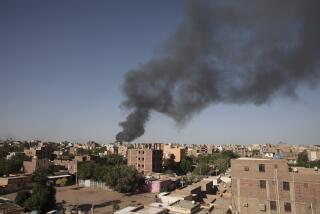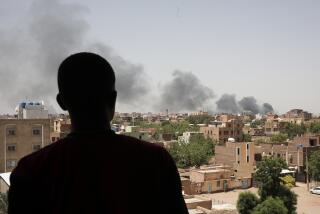Clash in Mogadishu Raises Fears of Increased Violence
- Share via
WASHINGTON — U.S. Marines clashed with Somali civilians Monday in what some officials said could be a harbinger of the worst possible ending to the U.S. intervention in the East African country: the prospect of a series of last-minute attacks as American troops withdraw.
The incident in Mogadishu, the Somali capital, came as U.S. forces began the final phase of their promised March 31 pullout. American officials said that the Marines fired only after they were fired on by Somali snipers, but Somali civilians said there was no such provocation.
Eight Somalis died in the incident, and several were wounded. It was unclear whether the dead were gunmen or were unarmed. U.S. officials said they were investigating the incident.
Publicly, diplomats and military officials have been predicting that Somalia’s long-feuding clan leaders--including Gen. Mohammed Farah Aidid--will reach an interim political settlement, enabling the United States to meet the March 31 deadline without incident.
But privately, officials here are sharply divided over the outlook for the next few weeks, with some worrying that the situation could deteriorate rapidly, eventually leading to a return of the devastating anarchy that prevailed before U.S. forces arrived in late 1992.
“No one really knows--it could go either way,” said a senior U.S. diplomat who has been close to the situation. “We’re watching it from day to day.”
Incidents such as Monday’s clearly are on the rise. Last week, Somali militiamen opened fire on a U.N. convoy, seriously wounding a Saudi soldier. And gangs of guerrillas went on a rampage in the central town of Belet Huen, looting a U.N. warehouse and forcing British relief workers to leave.
By planners’ reckoning, the U.S. withdrawal, which began in early December, is right on schedule. About 3,100 of the 7,600 U.S. ground forces on duty in Somalia then--mostly logistics troops and a few combat units--have left.
By mid-February, officials said, only about 2,500 U.S. ground troops will remain on Somali soil, and by March 31 the entire U.S. military contingent will be gone.
Washington continues to bank on the notion that the warlords--Aidid in particular--will become convinced that launching any attacks between now and the U.S. departure date is not in their interest and could bring new destruction that might weaken them as leaders.
Although headlines in the United States have focused on the 18 U.S. servicemen who were killed in an abortive Oct. 3 raid against Aidid, thousands of Somalis have died in clashes with U.N. forces in the last year.
U.S. officials contended that many of Aidid’s key lieutenants now recognize that and do not want to risk the possibility of hundreds more casualties among their own people. “The last thing they want to do is have a confrontation with the United States,” one diplomat asserted.
But as Monday’s incident demonstrated, the possibility of continuing confrontations between departing U.S. troops and Somali militiamen is acute, and the prospect that the Somalis will “test” the U.N. forces that stay behind is even greater.
As a result, the Clinton Administration, which previously appeared to underestimate the threat that the Somali militiamen posed, is taking extra precautions to protect the Americans’ flanks as the last of the U.S. units pull out:
* Military officials said that the United States will keep enough combat forces--as well as tanks and attack helicopters--in Somalia to quell any major disturbances until the last U.S. units are ready to depart.
* The withdrawal will be gradual, with American troops closely covering the seaport and airport in Mogadishu--the debarkation points for U.S. personnel and equipment--right up until the end.
* The Pentagon also has ordered a second 2,200-man Marine expeditionary unit to join the one now stationed off the Somali coast through the final weeks of the withdrawal and first few days of U.N. occupation.
* And the United States and its allies have stationed additional warplanes at the sprawling U.S. base in Diego Garcia, a British island in the Indian Ocean, in case hostilities erupt. Also on tap are AC-130H gunships.
U.S. officials said that how much of this arsenal will be needed is anyone’s guess.
Senior U.S. diplomats are scheduled to meet with key clan leaders in Kenya this week to help hammer out a political settlement, amid what some consider to be optimistic signs that the outlines of an interim agreement may be within reach.
Besides the talks with Western officials, Somali chieftains themselves have been negotiating behind the scenes, and diplomats said that both clan elders and religious leaders have begun talking about some sort of power-sharing accord.
The key question is over how to divide up the participation in any new government. “That’s what they’ve been thrashing around in Nairobi,” a U.S. diplomat said.
At the same time, with U.S. prodding, the United Nations is moving to address some of Aidid’s most pressing concerns.
The Security Council is preparing a new resolution--which could pass this week--expected to mandate a much-reduced U.N. role after the U.S. withdrawal. The measure calls for “voluntary” disarmament, with modest U.N. aid to those clan factions that go along.
But while the diplomats have become more optimistic, U.S. strategists worry that the situation on the streets has become potentially more dangerous--particularly in Mogadishu.
According to reports from that city, Somali youths toting M-16 rifles and AK-47 assault weapons once again have become fixtures downtown. Militiamen have taken over some key checkpoints. And violence is on the rise.
Washington’s nightmare is that Somali militiamen will launch an eleventh-hour attack on departing U.S. forces, reminiscent of North Vietnam’s rout of Saigon in 1975. The visions of American forces caught in a panicky retreat from there by helicopter still are fresh in planners’ minds.
U.S. forces already are training Malaysian and Pakistani troops, who will take over the bulk of the enforcement burden after the Americans leave.
But senior U.S. officials said that they are worried that the U.N. forces may be hampered by the same ambiguous strategy and chain of command that have plagued U.N. operations throughout the Somali venture.
More to Read
Sign up for Essential California
The most important California stories and recommendations in your inbox every morning.
You may occasionally receive promotional content from the Los Angeles Times.













